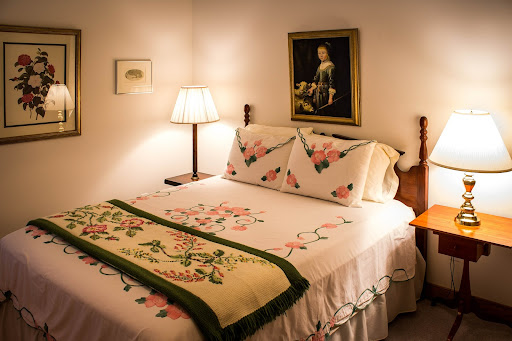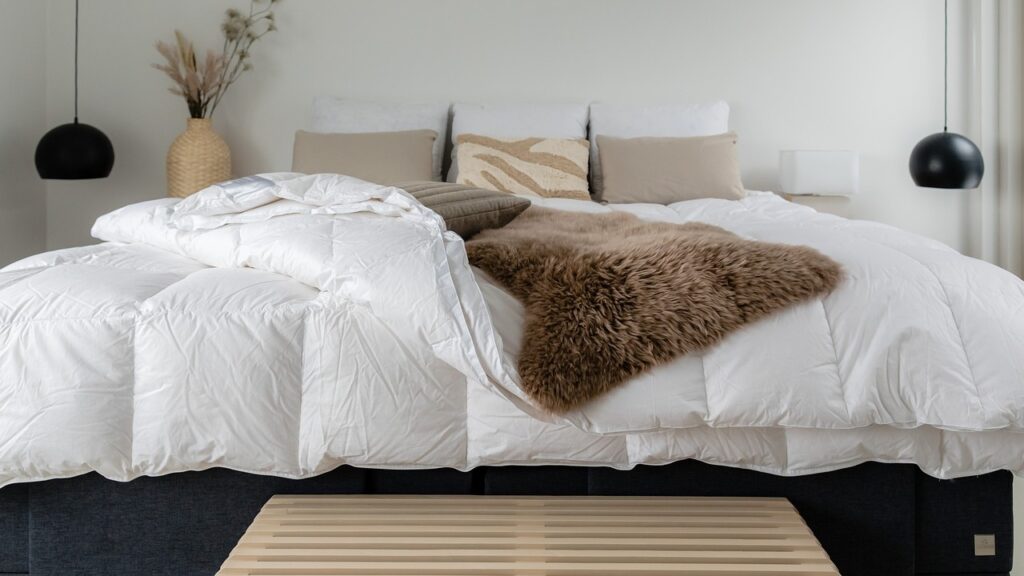Choosing between a bedspread and a comforter can be a significant decision when it comes to your bedding. Both options offer their unique benefits and considerations, and the choice ultimately depends on your specific preferences, needs, and the look you want to achieve in your bedroom. In this comprehensive guide, we will delve into the differences between bedspreads and comforters, explore their pros and cons, and help you make an informed decision about which one to buy.

A bedspread is a type of bedding that covers the entire bed, including the mattress and box spring, and often reaches all the way to the floor on all sides. Bedspreads are designed to provide a polished and cohesive look to your bed and bedroom decor. They are typically made from lightweight materials and are intended to be used as a top layer of bedding.
Pros of Bedspreads:
- Aesthetic Appeal: Bedspreads are primarily chosen for their visual appeal. They come in a wide range of colors, patterns, and designs, allowing you to coordinate your bedding with your overall interior design. Bedspreads can instantly transform the look of your bedroom, creating a stylish and inviting atmosphere.
- Bed Protection: Bedspreads serve as a protective layer for your mattress and box spring. They help prevent dust, dirt, and wear and tear from reaching the underlying bedding components, extending their longevity.
- Tidiness: Bedspreads create a neat and polished appearance for your bed. They cover the entire bed, including the area under the bed, hiding any clutter or storage items. This results in a clean and organized look for your bedroom.
- Layering Options: Bedspreads are versatile and can be easily layered with other bedding elements, such as blankets, quilts, or comforters. This allows you to adjust the level of warmth and insulation according to your needs and the season.
- Seasonal Decor: Bedspreads can be switched out to match different seasons or holidays. This flexibility allows you to refresh your bedroom’s decor without the need for a complete bedding overhaul.
Cons of Bedspreads:
- Limited Warmth: Bedspreads are not primarily designed for warmth. They are typically made from lightweight and breathable materials, which may not provide sufficient insulation in colder weather or during the winter months. If you live in a cold climate or prefer a warmer sleep environment, additional layers of bedding may be necessary.
- Maintenance: Bedspreads require regular maintenance to keep them clean and looking their best. They should be washed or dry-cleaned according to the manufacturer’s instructions. Some bedspreads may be more challenging to clean due to their size and material, which can be a drawback for those seeking low-maintenance bedding options.
- Layering Complexity: While the ability to layer bedspreads is an advantage, it can also be seen as a disadvantage for those who prefer a simpler bedding setup. Layering requires additional items like blankets or comforters, which can increase the cost and complexity of maintaining your bedding.
- Warm-Weather Preference: Bedspreads are better suited for warmer climates or individuals who prefer cooler sleeping conditions. If you tend to sleep hot, a bedspread can provide a breathable and lightweight bedding option.
Understanding Comforters

A comforter is a thick, quilted, and padded bedding item designed primarily for warmth and insulation. It typically consists of two layers of fabric stitched together with a layer of filling (such as down, synthetic fill, or cotton). Comforters come in various sizes to fit different bed dimensions and are known for their ability to provide coziness and heat retention.
Pros of Comforters:
- Warmth and Insulation: Comforters are specifically designed to provide warmth and insulation, making them ideal for cold weather or individuals who prefer a cozy and snug sleep environment. They are thicker and heavier than bedspreads, making them excellent for winter use.
- Versatility: Comforters can be used as standalone bedding without the need for additional layers in colder climates. They are available in various thicknesses and warmth levels, allowing you to choose the one that suits your preferences.
- Easy Maintenance: Comforters are generally easy to care for. Many comforters are machine washable, which simplifies the cleaning process. Regular washing helps maintain the comforter’s freshness and fluffiness.
- Wide Range of Styles: Comforters come in a wide range of colors, patterns, and designs, catering to various style preferences. Whether you prefer a classic, modern, or eclectic look for your bedroom, you can find a comforter to match.
Cons of Comforters:
- Aesthetic Considerations: While comforters can add style to your bed, they do not provide the same polished and draped appearance as bedspreads. Comforters often cover only the top of the mattress and may not reach the floor on all sides, which can affect the overall look of your bed.
- Limited Bed Protection: Comforters are primarily designed for warmth and comfort, so they do not offer the same level of mattress and bed protection as bedspreads. They typically cover only the top surface of the bed, leaving the sides and underbed area exposed.
- Layering Challenge: Comforters can be challenging to layer with other bedding elements like blankets or quilts due to their thickness. Adding multiple layers can create excess bulk, making it harder to achieve a tidy and well-made bed.
- Seasonal Limitations: While comforters excel in providing warmth during colder months, they may be too hot for summer use or in warmer climates. Seasonal variation in bedding may be necessary if you opt for a comforter.
Which One Should You Buy?
Now that we’ve explored the pros and cons of bedspreads and comforters, you can make an informed decision based on your specific needs, preferences, and lifestyle:
Consider a Bedspread If:
- Aesthetic Appeal is a Priority: If you prioritize a polished and decorative look for your bed and bedroom, a bedspread is an excellent choice. Bedspreads come in a wide range of colors and patterns, allowing you to coordinate your bedding with your interior decor.
- You Prefer Lightweight Bedding: If you live in a warmer climate or simply prefer lightweight and breathable bedding, a bedspread is a suitable option. It provides a tidy and stylish appearance without adding excess warmth.
- You Enjoy Seasonal Decor Changes: If you like to change your bedroom’s decor with the seasons or holidays, bedspreads offer flexibility. They can be easily switched out to match different themes or color schemes.
- You Want Bed and Mattress Protection: Bedspreads serve as protective layers for your mattress and box spring, helping to keep them clean and free from dust and wear.
Consider a Comforter If:
- Warmth and Coziness Are Essential: If you live in a cold climate, experience chilly nights, or simply enjoy a warm and snug sleep environment, a comforter is an excellent choice. It provides the insulation and heat retention needed for a comfortable night’s sleep.
- Low-Maintenance Bedding is Preferred: If you prefer bedding that is easy to care for, many comforters are machine washable, simplifying the cleaning process. Regular washing helps maintain the comforter’s freshness and functionality.
- Versatility Is Important: Comforters are versatile and can be used as standalone bedding in colder seasons. They come in various warmth levels, allowing you to choose one that suits your needs.
- A Wide Range of Styles Appeals to You: Comforters offer a wide variety of styles, colors, and patterns, catering to different design preferences. Whether you prefer a classic, modern, or eclectic look, you can find a comforter to match your bedroom decor.
- You Have Additional Bedding Layers: If you already have blankets, quilts, or other bedding layers that you enjoy using, a comforter can be an excellent addition to provide extra warmth and insulation during colder months.
Finding the Right Balance
It’s worth noting that you can also find a balance between bedspreads and comforters by using them in combination. For instance:
- Layering: You can use a bedspread for its decorative qualities and layer a comforter on top for added warmth during colder seasons. This approach allows you to enjoy the aesthetic appeal of a bedspread while benefiting from the insulation provided by the comforter.
- Seasonal Changes: You can switch between a bedspread and a comforter based on the season. Use a bedspread during the warmer months for a lighter feel and switch to a comforter during the colder months for added warmth.
- Styling: Consider using a bedspread as the top layer for its stylish and draped appearance and fold a comforter neatly at the foot of the bed for easy access and extra warmth when needed.
Conclusion
The choice between a bedspread and a comforter ultimately depends on your priorities, preferences, and specific bedding needs. Bedspreads excel in providing a polished and decorative look, making them ideal for those who prioritize aesthetics and live in warmer climates. Comforters are designed for warmth and coziness, making them a great choice for colder regions or individuals who enjoy a snug sleep environment.
To make the best decision, consider your climate, interior design style, need for warmth, and your willingness to maintain your bedding. You can also mix and match these bedding options to find the perfect balance of style and comfort for your bedroom. Ultimately, the ideal choice is the one that suits your unique lifestyle and personal taste.


